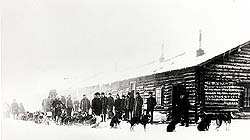 |
 
 |
 |
HARDSHIPS
Unpredictable weather – extreme cold, snowstorms or snow squalls – presented a constant challenge for the mail carriers and their dog-teams.
 |

NWMP Patrol Leaving Dawson, Yukon, with Mail for Herschel Island in the Arctic, December 29, 1908
Photo: J. Doody
© Public domain
National Library and National Archives
of Canada, C-042774
In 1899, the first winter patrol travelled between Dawson, Yukon and Fort McPherson, Northwest Territories. In 1904 and 1905, a regular winter patrol was established between the two towns, which enabled the mail service to extend into the Mackenzie Delta and Herschel Island.
|
During the winter of 1898-99, as U.S. mail carrier Corporal Richardson was nearing the Hootalinka post and "was about to go ashore with his outfit, the ice in the river began to move, broke up into pieces and swept the men down the stream. . . . The men narrowly escaped with their lives by hanging on to the limb of a tree – though every effort was made, the mail could not be recovered."61 While, in such cases, saving lives became paramount, the loss of irreplaceable mail was, for many, a tragedy. "Many a Christmas letter to friends in the east lies in drowned mail bags with not a few bank notes of small amounts, which the senders did not take the precaution to exchange for drafts."62 In other cases, where mail sacks were saved, the contents of the bag would often arrive damaged, with some of the letters rendered illegible.63

|
 |